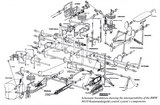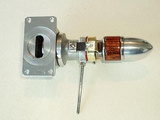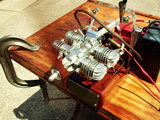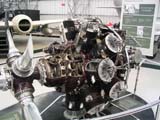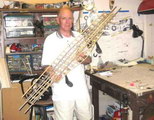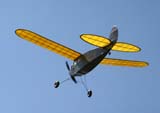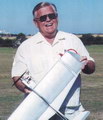Model Engine News: September 2013
Special Features:
Regular Features:
 Editorial
Editorial
 New Books and Magazines This Month
New Books and Magazines This Month
 Engine Of The Month: Argo .15
Engine Of The Month: Argo .15
 Tech Tip of the Month
Tech Tip of the Month
 Briefly Noted
Briefly Noted
 Standard Stuff
Standard Stuff
|
Unless otherwise expressed, all original text, drawings, and photographs created by Ronald A Chernich appearing on the Model Engine News web site are licensed under a Creative Commons Attribution-Noncommercial-Share Alike 3.0 License. |

|
Editorial
Yes, September is late, sorry. But I have an excuse, two actually. First, I have to acknowledge that my physical condition is worsening, meaning I just can't do as much as I used to, or would like, before having to lie down and take a nap, or drugs, or both. Each MEN issue requires at least twenty hours of work, some, much more. In times past, I could blast that out in two all-day sittings. If I'm realistic, it will now probably mean I have to start one as soon as the previous one is posted to make the deadline. Oh well, lesson learned. Next, for reasons as yet unexplained by my service provider, I got locked out of my own web site! This is a IP related lock-out, the same as some Members have suffered. Luckily, it eventually occurred to me that I could ssh to another location, then ssh from there to the MEN site and perform the update by the side-door, as it were, by using the different IP address. This I really did not need to discover on August 31, but that's life. Finally, you are going to notice that we are light on in the "news" department. Chalk that up to my drained energy, not material to present! Again, sorry, but I figure you'd rather have something then nothing.
Diesel Head
Members of the "oily hand" brigade may be happy to hear about a new product from NV Engines, namely a diesel head for their .04 to .06 range of glow motors. NV Engines (former Norvel) is a Russian manufacturer of very nice sport and competition two stroke glow engines, available in R/C (throttled) and C/L (plain venturi) versions. They have been around since 1992, steadily refining, improving, and expanding their product line, which is good as apart from Cox International—who are essentially assembling engines from old Cox/Estes parts inventory—NV are about the only game in town when it comes to high performance 1/2-A engines! NV also produce larger engines for airplanes and helicopters, with excellent spare parts availability.
Kommandogerat
Our book reviews last month about Kurt Tank and the FW-190/TA-152 brought responses from several readers who also appreciate this aircraft and its designer. Two sent in schematics from books in their own library detailing the combined engine speed, mixture, and manifold pressure single-lever system. We now know that it was designed by Dipl-Ing Karl Prestel, and was appropriately named the Kommandogerat. As Bob Allen remarked, the diagram clearly show how simple and straight forward the system was. Perhaps we now know why it has not seen wider use in today's light aircraft. All I can add is that my appreciation and regard for German engineers (and the ground staff who maintained this thing) has increased significantly!
RJS Victor
This shot was sent to Motor Boy, Les Stone, by our good pal, the late Roger Schroeder. It shows Roger's Victor at an early stage of construction in January, 2000. In the email containing the photo, Les told me something I did not know, namely that the name "Victor" was chosen as a tribute to Vic Didelot, another model engineer who was a mentor to Les (and others), back in the stone age. The Victor is a spark ignition engine based on the Vivell .09 diesel crankcase castings. Les' email also reminded me that I had a photo of the completed engine in the directory which used to serve as the cattle dog for Roger's "Classic Engines" kits, so if you click to the Roger Schroeder Tribute Page, you'll now find the photo of the completed engine in the middle of row thirteen.
Goose Egg
Speaking, as we were, of Les Stone, he recently took his ELF Goose Egg boxer four for a walk, which the poor thing had not enjoyed for ten year, to the month. All photos of flat four, two-strokes should stir the blood of any model engine enthusiast, although for those who know what is inside an Elf, the picture is all the more exciting. The shaft is obviously a "full-throw type", so the conrods need caps in order to assemble the engine. The way Dan Calkin, the Elf designer arranged this is via a very tiny clip-on, phosphor-bronze strap. That it works has always amazed me, let alone that it was produced in quantity and used on the Elf singles, and boxer twins, fours, and sixes! As to why it's called the "Goose Egg Four", click the link for new images on the Les Stone Tribute Page.
New Books and Magazines This Month
A couple of new and unexpected items found their way into The Library this past month, both of which have provided interesting and thought-provoking reading. Can't ask for more than that.
The First, is single issue of the Engine Collectors' Journal (ECJ), specifically, Volume 38, Issue #217, August 2013. As we mentioned back in July when reviewing ECJ Bound Volume 37, ECJ editor, Tim Dannels, was wrestling with the "year zero" problem and which issue would mark the 50th Anniversary Issue of ECJ. Well the decision has been made and it's now official, the first issue of Volume 38 marks Tim's Golden Anniversary for ECJ. Naturally, the issue begins with a description of the early days of model engine collecting and the history of how ECJ came to be, along with MECA and the four issues of The Model Engine Collector, produced by Joe Wagner, which preceded ECJ, and explains why ECJ's first issue is marked "#1, Volume 2". The cover, as we see here, is a 6x6 matrix of old ECJ covers. Simple math suggests that there is one volume not represented, provided no volume is represented twice. A fine exercise for a bleak afternoon would be to find out which one missed out!
Opening Volume 36, Issue #1, we find the regular cover with a rather striking engine that we've seen once before, many years ago, although it only had one ear then. The engine and associated parts and drawings has since changed hands and in his Engine of the Month feature, Tim conducts a more in-depth investigation of what turns out to be a rather unique, 1944 sleeve-valve, 2-stroke! I'm not going to repeat the article content here; buy the issue if you are intrigued. Better still, buy ALL the issues, bound in volumes, you'll never be sorry. However, as Tim has taken the vengeful academic's way out by suggesting that readers perform their own Internet research if they want to know more about sleeve valve engines, I'll add an observation, or three  .
.
The vast majority of sleeve valve engines are 4-strokes, where the sleeve is timed to move through its full path—be that linear or orbital—once for ever two turns of the crankshaft. Although the use of a sleeve valve dates back to the Argyll of 1913, the concept did not really take on until it was championed by Sir Roy Fedden, working for Bristol before and during World War II. Fedden argued that the poppet valve had reached its limit, as had bore and stroke, so to build larger and more powerful internal combustion engines without resorting to a staggering number of cylinders (as Wright, Lycoming, and others tried), the sleeve valve was the only answer. There are a lot more issues involved and I urge you to read the Fedden book referenced above to get a better appreciation of them.
Another person of note working on the same problem, at roughly the same time, was Sir Harry Ricardo, the man who "discovered" and tamed detonation. Harry agreed that the sleeve valve was required for high-speed, large capacity aero engines, going one further by advocating a two-stroke as the best choice to harness the available power. So was born the remarkable Rolls-Royce Crecy 12 cylinder, V configuration, 2-stroke, with sleeve valves. This, ultimately, was deemed a failure, or a dead-end as both it and the magnificent Bristol sleeve engines were literally run over by the gas turbine.
So why would a pair of 1944 model engine designers decide to build a single cylinder, 2-stroke, sleeve-valve engine? Ok, you may get better scavenging and be able to use grater exhaust and transfer port areas, but is the added complexity, weight, and cost of manufacture worth it? The ECJ article indicates that the sleeve drive went through two very different iterations and that the engines never went further than the prototype stage. The steel sleeve reciprocates in the aluminum liner with no rings. Likewise, the piston and "junk" head (to use the Bristol term) have no rings, making it a candidate for the term "slag" engine. I'll grant that the design is innovative, but to me it does not appear practical. If you are wondering about all those rings I just mentioned, look at a cut-away of a Bristol Hercules, or read the development hell saga our good friend, Lee Hodgson, of Ageless Engines is gradually winning through with his scale Bristol Hercules model.
I guess the best answer to the "why" question is "because they could", and there's not a damned thing wrong with that if you are not out to make a quick buck. This article ranks to me as one of the best in ECJ history, and even has some input on timing from fellow Motor Boy, David Owen.
Moving right along, the only other article in issue #217 is the first of a two-parter titled [The] DJS Racing Engine Story. DJS is a cunning combination of the initials of two gentlemen with impeccable credentials who developed AMA Nationals winning speed engines, initially using some Super Tigre parts in their own crankcase, with their own cylinder, piston, and head. Their names are Dub Jett and John Shannon (DJ + JS = DJS) and as they are the authors of the article(s), we are getting the story from the horse's mouth, so to speak. Part one is interesting and informative, and it contains one of the most delightful myth-busting disclosures I can recall in recorded model engine history.
The DJS cylinder liner design uses the now typical angled Schnurele transfer ports with a "boost" port, angled upwards at 50°. At the time, the DJS machine shop was an empty three car garage owned by Dub's dad, and their equipment did not stretch to a rotary table, so the port was cut in the cylinder blank, at the 50° angle using a simple cutter which resulted in an "eyebrow" shape (corners raised, so I imagine something like a Woodruf cutter with rounded edges was used). The boys knew this was a compromise, but needs be when the devil drives, and the first engine using this port design set a new B Class national record of 188.1 MPH at the 1973 Nats. Even though Dub and John gave a truthful reason for the port shape, it was not believed and so was copied by others as a "speed secret", as opposed to a lack of tooling!
The article is full of information and photos showing development stages, including twenty head button shapes tried, which resulted in the conclusion that the shape does not matter if the compression is right. They also make some very compelling remarks regarding cooling—or lack of it—when the engine only has to deliver peak power for about 30 seconds. I can't wait for part two...
So, if you have not guessed already, the 50th Anniversary issue of ECJ gets Five Gold Stars, and a Koala stamp! Well done Tim and Betty  .
.
Our second new Library item is a first for our monthly book reviews as you could call it an "eBook", given that it comprises two lengthy pdf (portable data format) articles, plus some videos, delivered on a DVD. The DVD title is Al's Models, and the author is William "Al" Rabe, who we mentioned last month in regard to shock absorbing landing gear struts. Al is credited with so many "firsts" in regard to innovations applied to control line aerobatics that listing them would a lengthy task, so let's just say that adjustable leadout-guides, tip-weight boxes, molded balsa fuselage shells, and coupled elevator/rudder to counteract adverse yaw due to gyroscopic precession in tight outside turns are just the tip of the iceberg. Well if you are into control line aerobatics, the two pdf articles on this DVD are, in my opinion, absolute must-read pieces that leave you thinking, as the very best How-To's do, "yes, I could do that..."
Seeing as August has been a bad time for me, health-wise, with long periods spent in bed, or in uncomfortable waiting room chairs at various medical imaging departments, having Al's articles loaded onto my iPad has made the time much more enjoyable that it might otherwise have been. Both are lavishly illustrated with very well composed and focused color photos and essentially cover the construction and painting of one of Al's P51 Mustang stunters, and the latest development of his "Mustunt" series I, II, and III, which appeared in American Aircraft Modeler, February, 1973. the new model is dubbed the Mustunt IV and has been evolved to look like the Heinkel He-100, especially after painting.
The build of the Mustang article contains Yet Another of those odd, serendipitous things which seem to happen far too often for coincidence: the engines which Al favors for his semi-scale stunters are the PA 65 and the Ro-Jett 65, the latter designed and made by a bloke named Dub Jett (where have we heard that name just recently?) As far as I can determine, neither are in production right now, as we mentioned last month. His Mustunt IV, a rather smaller and lighter design, uses an OS LA40, which is still available. All offer a solid 4-2-4 break run "out of the box", which we will have more to say about in this month's Tech Tip.
Both articles collect, integrate, and extend material which appeared on the Stuka Stunt Forum. Al adds other material to each from articles which have appeared in Flying Models, Stunt News, and Aeromodeller. I feel that I've learnt a lot by reading them, including a way to deal with swept-forward flap hinge lines which I knew about, but never believed would actually work before. You get everything here, from airframe to fuel tank construction, finishing, painting, and engine setup tips. Order the videos direct from Al. Another Five Gold Stars, and a Koala stamp  .
.
Engine Of The Month: Argo .15
Argo? Some older Australian readers will now be silently singing Row, Argonauts, row, Row, ROW!, but that is not it. The "argo" in this case is a nicely made replica of the old plain bearing Elfin 2.49cc diesel, designed by Frank Ellis. As it turns out, this is just one in a long line of replicas of that engine and this month, Adrian Duncan names the names and tests the Argo against the CS replica and the original itself to see how they stack up. He also examines the "replica" market with some opinions regarding it which I fully agree with, although he omits those replicas made for the dastardly purpose of defrauding gullible collectors. Thankfully, those have been very few, although that has not prevented the occasional "honest" replica being passed off as the genuine article, sometimes through malice aforethought, and sometimes through genuine ignorance. In most cases that I can think of, replica makers always include some way of telling their work from the original—the Argo being a good example of this laudable practice. I guess it's another case of caveat emptor for collectors, but then, learning how to tell an original from a replica is part of the joy of being a collector, and no-one ever said it'd be easy! So click the thumbnail, or follow this link to the Argo .15; Elfin 2.49 PB replica page.
Tech Tip of the Month
In last month's lament regarding the current lack of F2B, rear exhaust, competition engines, I mentioned the 4-2-4 run which is a characteristic of un-piped stunt engines. This was the last straw for one reader, who wrote saying:
I have seen on your site and other sites references to 2 cycle engines running a 4-2-4 pattern. A four cycle, two cycle, four cycle. How does that work? Don't you need a geared camshaft to be able to run 4 cycle? I am obviously missing something here. Any help clearing the fog would be appreciated.
What a great question! I truly enjoy it when someone reminds me of bits of knowledge which I take for granted, but really should not. Everyone has to start someplace and if you never ask, you'll never know. A site such as this should contain the answer to questions like this in some logical, easy to find location. The obvious location is the Frequently Asked Questions (FAQ) page, so if Greg's question seems like a good one to you too, deserving and equally good answer, click the link (Greg got the answer, and a big thank you, by return email). The smiling man in the picture is the late George Aldrich, one of the founder Motor Boys, whose name is tied forever to that "4-2-4 break"...
Briefly Noted
This section is intended to alert you to little things that are hard to expand to a full news item, or cunningly wind into the Editorial, but are worthy of note never the less.
- A bug in the Engine Finder was killing the link to the FROG 500 review. Fixed now.
- The Vivell .09 made by Les Stone which appears in column three, row nine, has been mis-labeled as an M&M 29 for a long time (cut and paste engine; look at the photo in the middle column of the same row). Fixed now, oops.


